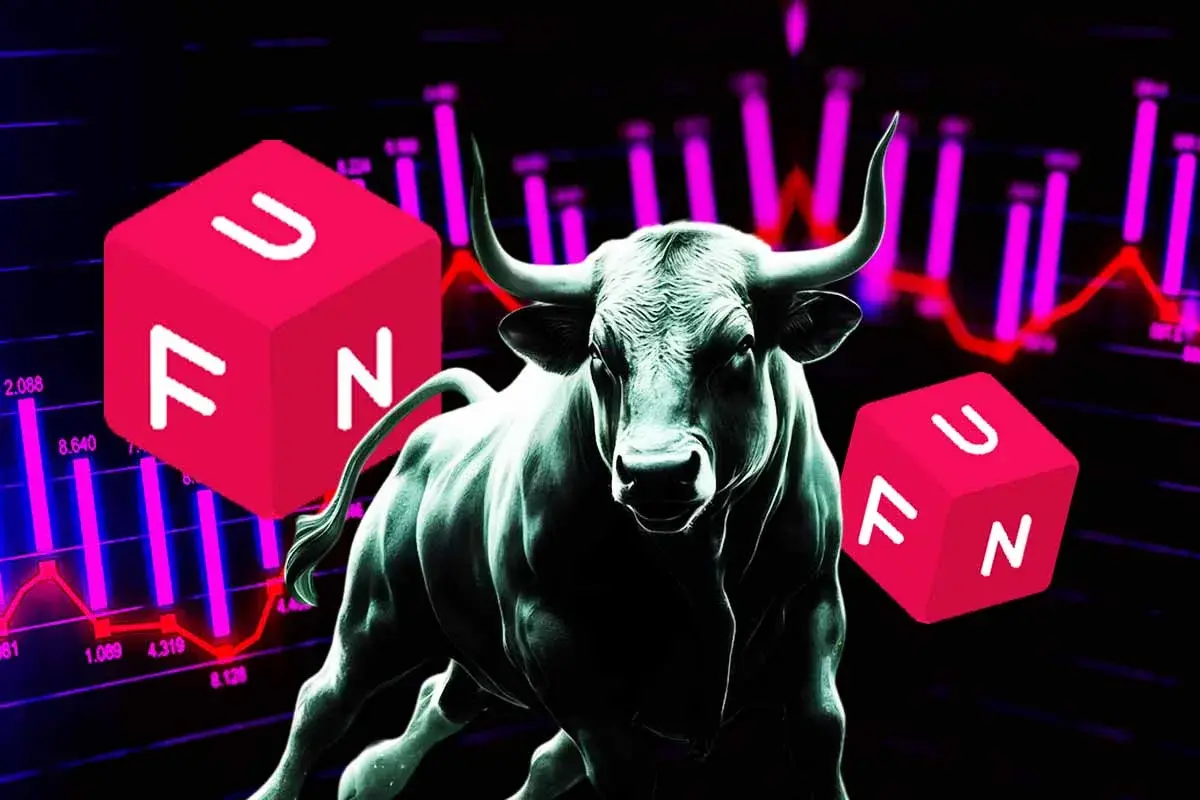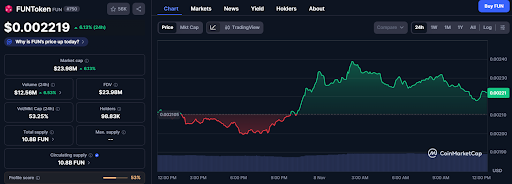Post-Giveaway Supply Shock: Impact on FUNToken’s Liquidity and Market Depth

The $5M FUNToken giveaway by 5m.fun has led to the locking of millions of $FUN into staking contracts, resulting in a short-term drop in circulating supply. As a result, the campaign is viewed as an event that could push the FUN price upward in the short term, but questions have been raised about the long-term impact of the campaign.
Giveaway Reducing Exchange Liquidity and Increasing Scarcity
FUNToken is currently trading just above the $0.00221 level and has a market capitalization of $23.98 million. There has been a 5.8% surge in value and over a $6.45 million surge in trading volume over the last 24 hours. Furthermore, the number of holders has increased to 98.83K.
The giveaway’s staking pool, which has already locked over 8.7 million $FUN, has been a contributing factor to this price pump. Short-term liquidity across exchanges has gone down, enforcing scarcity and boosting the price.
That being said, the unlocking of rewards will put the locked portion of those tokens back into circulation, potentially bringing the market back on track. That is why it is important for the project to find a way to manage stability as the giveaway fever subsides.
FUNToken’s Approach to Maintaining Stability After Post-Giveaway Liquidity Surge
Liquidity refers to the ease with which tokens can be bought or sold without significantly affecting the overall price of an asset. Locking millions of tokens means removing them from circulation, which causes liquidity to go down due to the lack of available tokens on the market.
Once the unlock period begins, liquidity starts to recover while stakers begin withdrawing their rewards. If not managed properly, the price could face a rapid decline. Therefore, keeping the following factors in mind is critical.
- Gradual Unlocking Mechanism : When tokens are unlocked gradually, they do not shock the market upon reintroduction. As the shock element is removed, post-unlock price action tends to remain stable.
- Restaking Incentives : FUNToken encourages investors to restake unlocked tokens by offering additional rewards. These include interest-based payouts and reinvestment opportunities, which help reduce withdrawals and prevent the asset’s price from dropping quickly.
- Community Retention Behavior : $FUN holders are currently active on social media, participating in engagement tasks, most of which are related to staking. Continued persistence of such engagement could prevent investors from leaving.
The overall goal is to reduce the intensity of withdrawals, thereby minimizing the shock element of the liquidity surge.
How Does FUNToken Managing Market Depth and Order Book Resilience
Market depth shows the number of buy and sell orders at various price points. Essentially, it measures how well the market can absorb trades without facing sharp price swings.
During a giveaway, this depth reduces as sell orders decline due to tokens being locked. As a result, buyers compete for the limited available supply. This boosts volatility, putting upward pressure on the token price in the short term.
After the event ends, however, order book depth increases again. FUNToken has attempted to create a structure that preserves measured liquidity, supporting a healthy post-event order book.
To achieve this, FUNToken will likely focus on the following factors:
- The pace at which rewards are withdrawn.
- Holder sentiment regarding $FUN in the long term.
- The addition of new staking or integration opportunities that reuse liquidity by directing it toward productive use.
By maintaining incentives for engagement, FUNToken effectively transforms short-term illiquidity into a controlled rebalancing process rather than a reversal.
Impact of Psychology on Liquidity Cycles
Psychology is another factor that influences liquidity as much as economics does. Holders who experience steady gains from staking may perceive $FUN as a yield-generating asset.
This leads to a “liquidity lag effect,” in which users delay selling because their tokens are earning. As a result, much of the supply remains inactive even when withdrawals are open.
The Telegram community, through conversations and announcements about rewards, creates optimism and engagement that reinforce this behavior. This social reinforcement is subtle but crucial, as it helps transform temporary scarcity into habitual holding.
Final Thoughts
Months after the giveaway is over, it is likely that liquidity will return. However, it will act as a stabilizing agent rather than causing a surge. A controlled reintroduction of tokens could expand market depth again, which can be considered a positive development. Investors may perceive FUNToken’s economy as a maturing one rather than an asset that has reverted to its pre-giveaway volatility.
In simple terms, the giveaway could be seen not as a way to compress supply, but to shift the liquidity rhythm of the FUN economy.
- Trump to Interview BlackRock’s Rick Rieder as Fed Chair Shortlist Narrows to Four
- Breaking: VanEck Discloses Fees and Staking Details for its Avalanche ETF
- Crypto Market Braces for Volatility as BTC, ETH Options Expiry Collides $7.1 Trillion ‘Triple Witching’
- Terraform Labs Lawsuit: Jump Trading Faces $4B Case over Market Manipulation
- Coinbase Challenges US States Over Regulatory Restrictions on Prediction Markets
- Dogecoin Price Prediction Points to $0.20 Rebound as Coinbase Launches Regulated DOGE Futures
- Pi Coin Price Prediction as Expert Warns Bitcoin May Hit $70k After BoJ Rate Hike
- Cardano Price Outlook: Will the NIGHT Token Demand Surge Trigger a Rebound?
- Will Bitcoin Price Crash to $74K as Japan Eyes Rate Hike on December 19?
- Bitwise Predicts Solana Price Will Hit New All-Time Highs in 2026
- Bitcoin Price Outlook: Capriole Founder Warns of a Drop Below $50K by 2028











